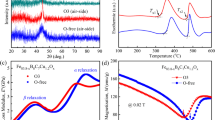Abstract
The cross-section of the Fe-based alloy (Fe73.5Cu1Nb3Si13.5B9) ribbon annealed at 540°C under various tensile stress was investigated with atomic force microscope (AFM). The stress effect mechanism in Fe-based alloy ribbon tensile stress annealed inducing transverse magnetic anisotropy field was studied using the X-ray diffraction spectra and longitudinal drive giant magneto-impedance effect curves, and the model of direction dominant in encapsulated grain agglomeration was established. The relationship between the direction dominant in encapsulated grain agglomeration and magnetic anisotropy field was disclosed.
Similar content being viewed by others
References
Fang Y Z, Wu F M, Zheng J J, et al. AFM research on Fe-based nanocrystal crystallization mechanism. Sci China Ser E-Tech Sci, 2008, 51(1): 46–57
Yoshizawa Y, Oguma S, Yanauchi K. New Fe-based soft magnetic alloys composed of ultrafine grain structure. J Appl Phys, 1988, 64(10): 6044–6049
Kraus L, Zavěta K, Heczko O, et al. Magnetic anisotropy in as-quenched and stress-annealed amorphous and nanocrystalline Fe73.5Cu1Nb3Si13.5B9 alloy. J Magn Magn Mater, 1992, 112: 275–277
Herzer G. Magnetic field induced anisotropy in nanocrystalline Fe-Cu-Nb-Si-B alloys. Mater Sci Eng A, 1994, 181–182: 876–879
Herzer G. Creep induced magnetic anisotropy in nanocrystalline Fe-Cu-Nb-Si-B alloys. IEEE Trans Magn, 1994, 30(6): 4800–4802
Hofmann B, Kronmüller H. Creep induced magnetic anisotropy in nanocrytalline Fe73.5Cu1Nb3Si13.5B9. Nanostr Mater, 1995, 6: 961–964
Hofmann B, Kronmüller H. Stress-induced magnetic anisotropy in nanocrystalline FeCuNbSiB alloy. J Magn Magn Mater, 1996, 152(1–2): 91–98
Kraus L, Hašlar V, Heczko O, et al. Creep-induced magnetic anisotropy and magnetostriction in partly nanocrystalline Fe74Nb3Cu1Si13B9 alloy. J Magn Magn Mater, 1996, 157–158: 151–152
Liu J Y, Chen W Z, Zhi Q Z. Stress annealing research on Fe73.5Cu1Nb3Si13.5B9 nacocrystalline iron core. Metal Funct Mater, 2005, 1: 7–10
Wang Z C, Gong F F, Yang X L, et al. Longitudinally driven giant magnetoimpedance effect in stress-annealed Fe-based nanocrystalline ribbons. J Appl Phys, 2000, 87: 4819–4821
Bensalah A-D, Alves F, Barrue R, et al. GMI sensors based on stress-annealed iron based nanocrystalline ribbons. Sens Actuat A, 2006, 129: 142–145
Lachowicz H K, Neuweiler A, Popkawski F, et al. On the origin of stress-anneal-induced anisotropy in FINEMET-type nanocrystalline magnets. J Magn Magn Mater, 1997, 173(3): 287–294
Ohnuma M, Hono K, Yanai T, et al. Direct evidence for structural origin of stress-induced magnetic anisotropy in Fe-Si-B-Nb-Cu nanocrystalline alloys. Appl Phys Lett, 2003, 83(14): 2859–2861
Flohrer S, Schafer R, Polak C, et al. Interplay of uniform and random anisotropy in nanocrystalline soft magnetic alloys. Acta Mater, 2005, 53: 2937–2942
Zeleňáková A, Fuzer J, Kollár P, et al. The influence of transverse magnetic anisotropy on domain structure and magnetic properties of FeCrCuSiNbB ribbons. J Magn Magn Mater, 2006, 304(2): e528–e530
Fang Y Z, Wu F M, Wu W H, et al. An AFM investigation of mesostructure of Fe-based nanocrystalline ribbon. Chin Sci Bull, 2004, 49(18): 1900–1905
Graf T, Hampel G, Korus J, et al. Influence of Nb concentration on structure and crystallization onset of amorphous Fe(Cu,Nb)SiB FINEMET alloys. Nanostr Mater, 1995, 6: 469–472
Author information
Authors and Affiliations
Corresponding author
Additional information
Supported by the Natural Science Foundation of Zhejiang Province (Grant No. Y405021), Key Project of Science and Technology of Zhejiang Province (Grant No. 2006C21109) and Key Project of Science and Technology Research of China Ministry of Education (Grant No. 204059)
Rights and permissions
About this article
Cite this article
Fang, Y., Zheng, J., Shi, F. et al. AFM research on the mechanism of Fe-based alloy stress annealed inducing magnetic anisotropy. Sci. China Ser. E-Technol. Sci. 51, 1409–1424 (2008). https://doi.org/10.1007/s11431-008-0156-z
Received:
Accepted:
Published:
Issue Date:
DOI: https://doi.org/10.1007/s11431-008-0156-z



